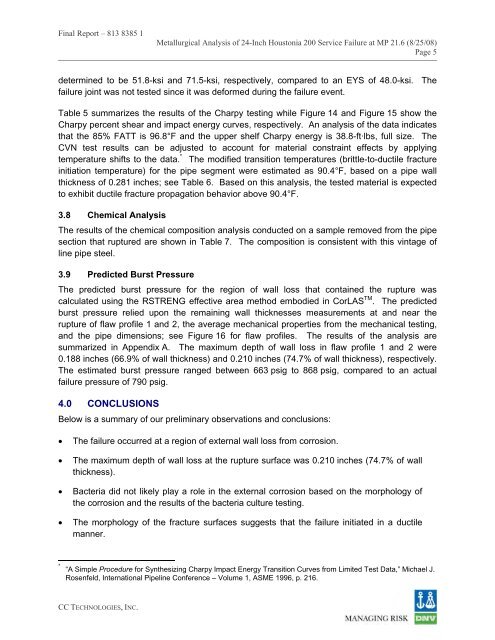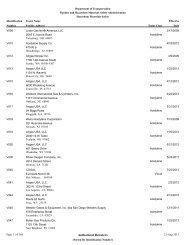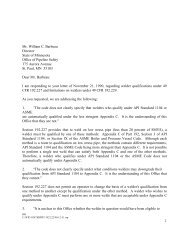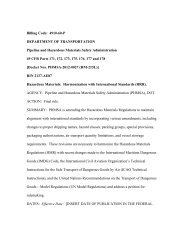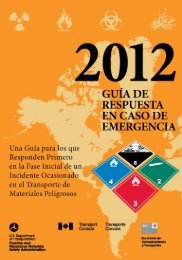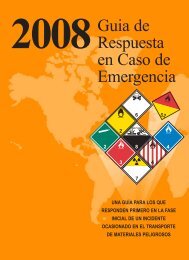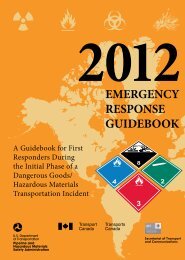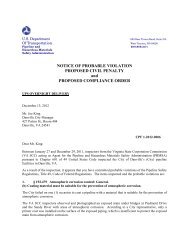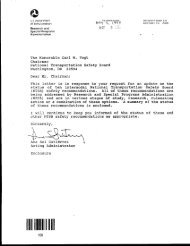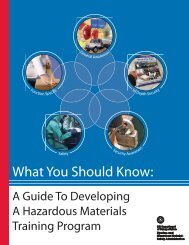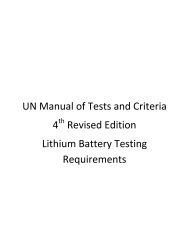Pipeline Failure Investigation Report - PHMSA - U.S. Department of ...
Pipeline Failure Investigation Report - PHMSA - U.S. Department of ...
Pipeline Failure Investigation Report - PHMSA - U.S. Department of ...
You also want an ePaper? Increase the reach of your titles
YUMPU automatically turns print PDFs into web optimized ePapers that Google loves.
Final <strong>Report</strong> – 813 8385 1<br />
Metallurgical Analysis <strong>of</strong> 24-Inch Houstonia 200 Service <strong>Failure</strong> at MP 21.6 (8/25/08)<br />
Page 5<br />
determined to be 51.8-ksi and 71.5-ksi, respectively, compared to an EYS <strong>of</strong> 48.0-ksi. The<br />
failure joint was not tested since it was deformed during the failure event.<br />
Table 5 summarizes the results <strong>of</strong> the Charpy testing while Figure 14 and Figure 15 show the<br />
Charpy percent shear and impact energy curves, respectively. An analysis <strong>of</strong> the data indicates<br />
that the 85% FATT is 96.8°F and the upper shelf Charpy energy is 38.8-ft·lbs, full size. The<br />
CVN test results can be adjusted to account for material constraint effects by applying<br />
temperature shifts to the data. * The modified transition temperatures (brittle-to-ductile fracture<br />
initiation temperature) for the pipe segment were estimated as 90.4°F, based on a pipe wall<br />
thickness <strong>of</strong> 0.281 inches; see Table 6. Based on this analysis, the tested material is expected<br />
to exhibit ductile fracture propagation behavior above 90.4°F.<br />
3.8 Chemical Analysis<br />
The results <strong>of</strong> the chemical composition analysis conducted on a sample removed from the pipe<br />
section that ruptured are shown in Table 7. The composition is consistent with this vintage <strong>of</strong><br />
line pipe steel.<br />
3.9 Predicted Burst Pressure<br />
The predicted burst pressure for the region <strong>of</strong> wall loss that contained the rupture was<br />
calculated using the RSTRENG effective area method embodied in CorLAS TM . The predicted<br />
burst pressure relied upon the remaining wall thicknesses measurements at and near the<br />
rupture <strong>of</strong> flaw pr<strong>of</strong>ile 1 and 2, the average mechanical properties from the mechanical testing,<br />
and the pipe dimensions; see Figure 16 for flaw pr<strong>of</strong>iles. The results <strong>of</strong> the analysis are<br />
summarized in Appendix A. The maximum depth <strong>of</strong> wall loss in flaw pr<strong>of</strong>ile 1 and 2 were<br />
0.188 inches (66.9% <strong>of</strong> wall thickness) and 0.210 inches (74.7% <strong>of</strong> wall thickness), respectively.<br />
The estimated burst pressure ranged between 663 psig to 868 psig, compared to an actual<br />
failure pressure <strong>of</strong> 790 psig.<br />
4.0 CONCLUSIONS<br />
Below is a summary <strong>of</strong> our preliminary observations and conclusions:<br />
• The failure occurred at a region <strong>of</strong> external wall loss from corrosion.<br />
• The maximum depth <strong>of</strong> wall loss at the rupture surface was 0.210 inches (74.7% <strong>of</strong> wall<br />
thickness).<br />
• Bacteria did not likely play a role in the external corrosion based on the morphology <strong>of</strong><br />
the corrosion and the results <strong>of</strong> the bacteria culture testing.<br />
• The morphology <strong>of</strong> the fracture surfaces suggests that the failure initiated in a ductile<br />
manner.<br />
*<br />
“A Simple Procedure for Synthesizing Charpy Impact Energy Transition Curves from Limited Test Data,” Michael J.<br />
Rosenfeld, International <strong>Pipeline</strong> Conference – Volume 1, ASME 1996, p. 216.<br />
CC TECHNOLOGIES, INC.


